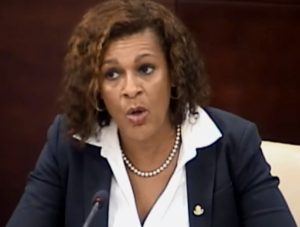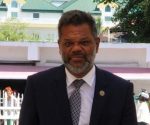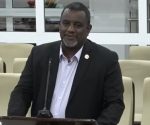Employability drives policy for tertiary education ordinance
 PHILIPSBURG – Employability becomes the main driver of higher education, Minister Jorien Wuite (Education, Culture, Youth and Sport) said during a meeting of the Central Committee of Parliament on Monday afternoon. The minister came to parliament to present an update on the state of affairs of the national ordinance on tertiary education – a piece of legislation that will guarantee the University of St. Martin structural funding.
PHILIPSBURG – Employability becomes the main driver of higher education, Minister Jorien Wuite (Education, Culture, Youth and Sport) said during a meeting of the Central Committee of Parliament on Monday afternoon. The minister came to parliament to present an update on the state of affairs of the national ordinance on tertiary education – a piece of legislation that will guarantee the University of St. Martin structural funding.
The focus on the link between higher education and the labor market is strong in Wuite’s presentation. The intention is “to tie the economic growth agenda and the needs of the labor market directly to the agenda for higher education,” Wuite said.
At the beginning of her presentation, the minister said that the drive to make work of the ordinance is driven by the fact that the university was battling a shortfall of 230,000 guilders per month after Hurricane Irma. “The reason to fast-track the legislation is to secure long term funding for USM.”
Wuite quoted former President Obama: “Higher education cannot be a luxury reserved for just a privileged few. It is an economic necessity to every family. And every family should be able to afford it.”
Wuite released some key data about St. Maarten’s education system. Annually there are around 8,000 children in the country’s schools; 3,000 of them are in secondary education from where 700 graduate each year. Just a bit more than half of those students (56.4 percent) continue their studies after secondary school; 245 go to the National Institute for Professional Advancement (NIPA) and 150 go to USM. In 2016, 124 out of 182 applications for study financing were approved for students who went to further their studies abroad.
Graduates from vocational secondary education still outpace grads from academic secondary schools; In 2015 the balance was 55 to 45 percent in favor of vocational graduates, but Minister Wuite said that the trend moves towards more academic graduates. In 2016 the gap narrowed to 53-47.
Minister Wuite touched on global and regional trends in higher education and noted that of all international students, 6 percent choose for the Caribbean.’
There are six key issues to consider for St. Maarten, Wuite said. They are the size and focus of the university, the role of the government, the planning of education, its financing, quality care and the role of foreign institutions.
The research paper The Development of Tertiary Education of Sint Maarten projects that by 2030 there will be two to three fully accredited Bachelor and Masters programs on St. Maarten in addition to Associates programs and e-learning. The focus is on life-long learning.
“The government invests up to a certain maximum percentage of the core costs,” the minister said.
The government intends to attract more foreign students to its university; it wants to put quality assurance in the hands of specialized agencies to maximize international quality assurance. Furthermore, the government wants to open up the system for “a well-known foreign public institute.”
It is unclear whether this is a reference to the American University of the Caribbean AUC) in Cupecoy, but Minister Wuite later said that the AUC, together with the USM is considered a stakeholder in the development of the legislation for tertiary education.
The first draft of the ordinance is available and the ministry is working on finalizing it. In this process there will be first informal consultation with stakeholders USM and AUC, followed by formal consultations in a later stadium when the Social Economic Council (SER) will also get a say in the matter. The informal consultations will begin towards the end of this month, Wuite said.
Photo caption: Minister of Education Jorien Wuite. Photo screenshot sxmparliament.org.























